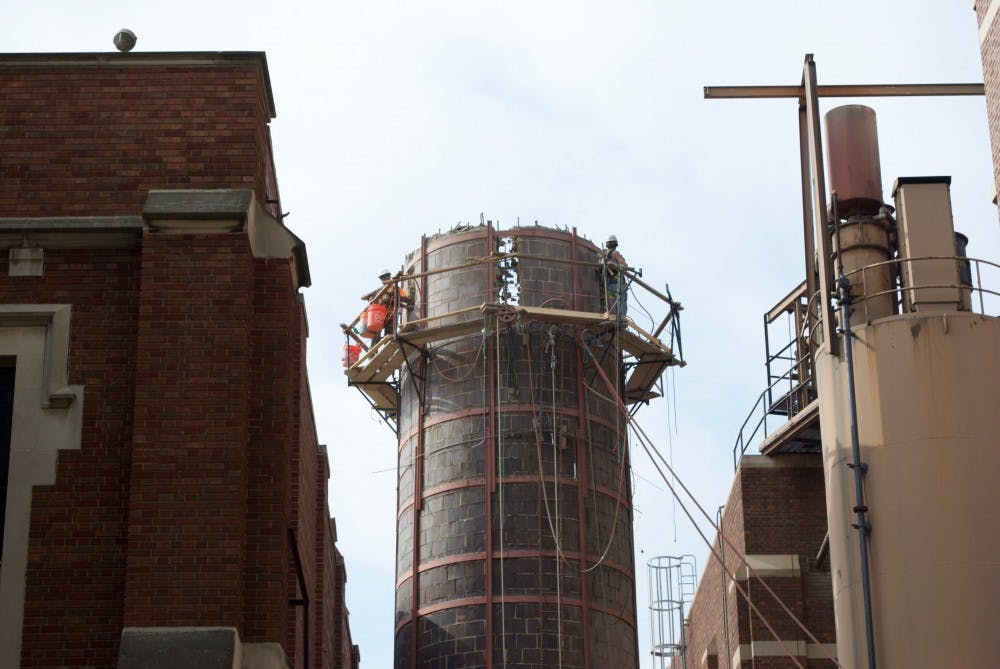After being rendered obsolete with the installation of the nation’s largest closed-loop geothermal energy system, two smokestacks—located at the energy heat plant on the southwestern edge of the Ball State campus—are coming down.
Workers from the St. Louis-based Gerald Chimney Company have been slowly dismantling the two smokestacks since July 26. In their prime, the west stack stood 180-feet tall while the east stack was 125-feet tall.
The removal process involves construction crews cutting a hole in the base of each stack. Bricks are then knocked inward from the top of the stack down, and workers haul away the piled debris from the base. The removal project is expected to be completed by Aug. 26.
Before construction on Ball State’s geothermal system began in 2009, the plant burned nearly 36,000 tons of coal per year. Drilling began for nearly 3,600 boreholes around campus for a large-scale heat pump system in 2010 before the four coal-fired boilers used to heat and cool the campus—which dated back to the 1940s—were permanently shut down in 2014.
Since then, the geothermal system has begun tapping into the Earth’s natural heat storage capacity to both heat and cool, while the heat plant burns natural gas instead of coal to produce steam for heating and hot water.
The removal of the two exhaust stacks is symbolic of the university’s sustainability position said Jim Lowe, Ball State’s associate vice president for facilities planning and management.
The geothermal system significantly cuts down on the release of greenhouse gases into the atmosphere, eliminating the emission of more than 75,000 tons of carbon dioxide each year.
And while the smokestack expulsion marks the final stages of the $83 million geothermal project, Lowe said the university’s decades-long sustainability efforts will continue “into the future and beyond.”
University leadership is committed to continuing to build and renovate buildings to make them more energy efficient, Lowe added, and Ball State’s Sustainability Working Group—which was established to determine the feasibility of going carbon neutral in the future—is also studying new project opportunities.
New projects are guided by Leadership in Energy and Environmental Design (LEED) standards, a rating system used to evaluate the environmental performance of a building and encourage market transformation towards sustainable design.
Other university sustainability projects completed in the last few years have focused on the installation of LED lighting systems, with a few of the bigger projects taking place in the Jo Ann Gora Student Recreational Center and Lewellen Pool. Currently, another project is underway to replace the football stadium lighting with energy-saving LEDs.
Lowe said the new geothermal system and similar project initiatives also have a focused effort to weave sustainability into courses taught at the university. With classes routinely taking tours of the geothermal system to learn more about how it works, the goal is that more students will be more aware of green energy possibilities.
“Ball State graduates at some time, in any career, can support efforts towards bettering the environment,” Lowe said.
The geothermal system saves the university more than $2 million annually on energy costs, and it’s also reaped benefits for the local economy. The project created 2,300 direct and indirect jobs for many contractors who were Indiana natives, and the system was constructed with American-made products.
Even as the university continues to expand spatially, Lowe said that the current capacity of the geothermal system—based on the campus master plan—can supply the heating and cooling needs well into the future.
“One of the great attributes of the geothermal system design is that it can be expanded to meet the needs of the campus,” Lowe said.
Building additions like the new Health Professions Building and East Mall will be connected to the geothermal system, Lowe said, continuing opportunities for more sustainable development practices to take place across the campus.





